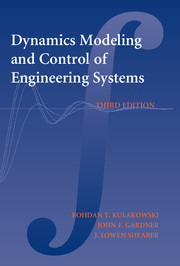Book contents
- Frontmatter
- Contents
- Preface
- Dynamic Modeling and Control of Engineering Systems
- 1 INTRODUCTION
- 2 MECHANICAL SYSTEMS
- 3 MATHEMATICAL MODELS
- 4 ANALYTICAL SOLUTIONS OF SYSTEM INPUT–OUTPUT EQUATIONS
- 5 NUMERICAL SOLUTIONS OF ORDINARY DIFFERENTIAL EQUATIONS
- 6 SIMULATION OF DYNAMIC SYSTEMS
- 7 ELECTRICAL SYSTEMS
- 8 THERMAL SYSTEMS
- 9 FLUID SYSTEMS
- 10 MIXED SYSTEMS
- 11 SYSTEM TRANSFER FUNCTIONS
- 12 FREQUENCY ANALYSIS
- 13 CLOSED-LOOP SYSTEMS AND SYSTEM STABILITY
- 14 CONTROL SYSTEMS
- 15 ANALYSIS OF DISCRETE-TIME SYSTEMS
- 16 DIGITAL CONTROL SYSTEMS
- APPENDIX 1 Fourier Series and the Fourier Transform
- APPENDIX 2 Laplace Transforms
- APPENDIX 3 MATLAB Tutorial
- APPENDIX 4 Simulink Tutorial
- Index
9 - FLUID SYSTEMS
Published online by Cambridge University Press: 05 June 2012
- Frontmatter
- Contents
- Preface
- Dynamic Modeling and Control of Engineering Systems
- 1 INTRODUCTION
- 2 MECHANICAL SYSTEMS
- 3 MATHEMATICAL MODELS
- 4 ANALYTICAL SOLUTIONS OF SYSTEM INPUT–OUTPUT EQUATIONS
- 5 NUMERICAL SOLUTIONS OF ORDINARY DIFFERENTIAL EQUATIONS
- 6 SIMULATION OF DYNAMIC SYSTEMS
- 7 ELECTRICAL SYSTEMS
- 8 THERMAL SYSTEMS
- 9 FLUID SYSTEMS
- 10 MIXED SYSTEMS
- 11 SYSTEM TRANSFER FUNCTIONS
- 12 FREQUENCY ANALYSIS
- 13 CLOSED-LOOP SYSTEMS AND SYSTEM STABILITY
- 14 CONTROL SYSTEMS
- 15 ANALYSIS OF DISCRETE-TIME SYSTEMS
- 16 DIGITAL CONTROL SYSTEMS
- APPENDIX 1 Fourier Series and the Fourier Transform
- APPENDIX 2 Laplace Transforms
- APPENDIX 3 MATLAB Tutorial
- APPENDIX 4 Simulink Tutorial
- Index
Summary
LEARNING OBJECTIVES FOR THIS CHAPTER
9–1 To recognize the A-, T-, and D-type elements of fluid systems.
9–2 To use laws of continuity and compatibility to develop lumped-parameter models of hydraulic fluid systems.
9–3 To model lumped-parameter compressible (pneumatic) fluid systems by use of ideal gas assumptions.
INTRODUCTION
Corresponding to the mass, spring, and damper elements discussed in Chap. 2, the A-type, T-type, and D-type elements used in modeling fluid systems are the fluid capacitor, the fluid inertor, and the fluid resistor elements.
Capacitance occurs as a result of elasticity or compliance in the fluid or in the walls of the container. Although liquids such as water and oil are often considered to be incompressible in many fluid flow situations, these hydraulic fluids are sometimes compressible enough to produce fluid capacitance. In other cases, the walls of the chambers or passages containing the fluid have enough compliance, when the fluid pressure changes rapidly, to produce fluid capacitance. In long lines and passages, fluid capacitance is distributed along the line, together with inertance and resistance, and the analysis of such situations is beyond the scope of this text. If both the resistance and inertance are negligible, however, it is possible to use a lumped-capacitance model of the line.
When fluid capacitance is wanted for energy-storage purposes, specially designed off-the-shelf capacitors with minimal resistance and inertance, called hydraulic accumulators, are used. Storage tanks and reservoirs also serve as fluid capacitors.
- Type
- Chapter
- Information
- Dynamic Modeling and Control of Engineering Systems , pp. 219 - 248Publisher: Cambridge University PressPrint publication year: 2007



